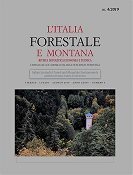Published 2019-10-03
Keywords
- eucalyptus,
- working system,
- firewood; logging,
- economic and environmental sustainability
Copyright (c) 2019 Italian Journal of Forest and Mountain Environments

This work is licensed under a Creative Commons Attribution-NonCommercial 4.0 International License.
Abstract
Traditionally, the utilization of short rotation coppices focuses on production of wood chips for energy or industrial purposes. In recent years, due to the lack of funding in the RDPs of the regions, surfaces destined to this type of crop were drastically reduced, causing a crisis in the wood chip market. It is therefore necessary to think of new forms of use, which in the case of eucalyptus could be represented by firewood. On this subject, within the AGROENER project, a research action is carried out with the aim on recovery and valorisation of residual biomasses of forest utilization and verification of the economic sustainability of firewood production from eucalyptus coppices managed as short rotation. During the utilization of a 4-year-old coppice, two firewood production systems have been compared: the traditional one, the Short Wood System (SWS) and the Whole Tree System (WTS). The growing stock per hectare was 73.56 t, with 68% (49.91 t) of firewood. The gross productivity of the work site, adopting the SWS, was 0,77 t h-1 per operator, respect to 0,86 t h-1 obtained with WTS. Wood production costs were € 30.78 t-1 for the SWS, and € 28.59 t-1 for the WTS, with values per hectare of € 2,264 and € 2,103, respectively. Considering equal to € 60 t-1 the current sale value of firewood and € 10 t-1 that of residuals (only for the WTS), the gain for both work systems are 9.93 € t-1 for the SWS and € 15.33 t-1 for the WTS. These results are discussed in relation to economic and environmental aspects of the forest utilization.

